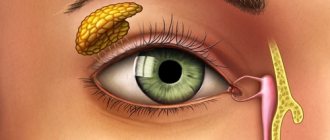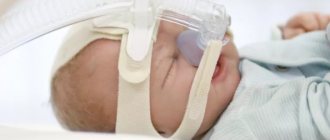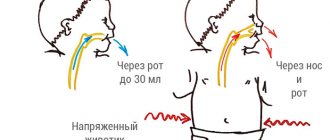Adenotomy is a surgical procedure in the field of otorhinolaryngology, and is used to treat lymphoid hyperplasia or hyperplasia of the pharyngeal tonsil.
The underlying cause of hyperplasia (enlargement) of the nasopharyngeal tonsil or adenoid vegetations is not known. However, there is evidence of a relationship between adenoid hyperplasia and recurrent infections, dietary habits, hormonal changes, and a hereditary predisposition. Hyperplasia of adenoid vegetations usually occurs in children between two and five years of age.
Main consequences of enlarged adenoids
The consequences of adenoids arise due to their anatomical location: patients, and these are always children, have problems with nasal breathing, speak with a nasal voice (nasal), snore during sleep, and often suffer from ARVI for a long time. In advanced cases, the symptom is the so-called adenoid face: a typical condition that occurs when breathing through a mouth that is constantly open.
Decreased performance at school is the result of hypoxia (oxygen starvation) and, as a result of poor concentration, insomnia, patients quickly get tired and often have problems eating. A number of chronic diseases may also occur:
- Rhinitis.
- Laryngitis.
- Tracheitis.
- Bronchitis.
- Tubular catarrh with effusion into the tympanic cavity or eustacheitis - inflammation of the Eustachian tubes (the connection between the ear and throat).
- Catarrhal or purulent otitis.
Surgery to remove adenoids is not a tragedy
Otolaryngologist for adults and children
Manevich
Igor Semenovich
25 years of experience
Otorhinolaryngologist of the highest category, member of the European Rhinologic Society
Make an appointment
In my practice, I have encountered the fact that many parents refuse to have their children undergo surgery to remove adenoids, because it is associated with many difficulties: blood vessels begin to bleed, the child experiences pain. And this is understandable. But there is no need to be afraid if the operation is performed under anesthesia. Otorhinolaryngologist Igor Semenovich Manevich talks about what adenoids are and what their functions are.
About difficulties in feeding children
The little man has this peculiarity: he cannot suckle, cannot eat, when his nose is not breathing. When a mother brings her child to an appointment, the first thing the ENT doctor asks is how the child is gaining weight. This may seem strange for a mother, but in fact this is the most important thing for us. If the child eats well and gains weight within normal limits, then there is absolutely no reason for concern, even if it seems to the mother that he is making some sounds or sniffling. It happens that a child sucks poorly at the breast due to swelling of the nasal mucosa. This can be corrected with drops and sprays, but it is impossible to give specific advice, you need to look at the child every time, and each time the doctor must prescribe treatment individually. There are situations when children cannot breathe from birth, from the first days. This is due to the fact that due to the anatomical feature, the nose is blocked and the choanae are blocked. The choanae are the 2 “holes” that end the nose (like the two nostrils at the front). Congenital fusion (atresia) occurs when the choana is covered with film or bone. If the child is not gaining weight and is not breathing, then the choanae should be examined. This requires hospitalization and anesthesia. We look with an endoscope to see if the choanae are really blocked. If yes, then we immediately perform an operation and free them. Then you have to wait for them to heal. This is a long process.
About the difference between snoring and snoring
Snoring is not a pathology, it is a soft sound that is pleasant to the mother’s ears. And snoring sounds harsher and is produced by deeper structures of the nose and nasopharynx; the mouth is usually open, and this is always worse. In other words, if a child sniffles, then this is normal, but snoring is a reason to worry.
In children over 1 year of age, snoring and snoring are associated with adenoid problems. If a child snores comfortably in his sleep, then this is good; he can roll over to the other side and stop snoring. But if in his sleep he snores heavily or breathes through his mouth, walks with his mouth open during the day and also often catches a cold, it is noted that he hears worse, this means that adenoids have grown in his nasopharynx and have blocked his nasal breathing and ears from the inside from the outside eustachian tubes. In this case, it is also important not to miss the moment when adenoids can be treated with medication: reducing their size. Doctors divide adenoids into 3, and some into 4 stages. If the first is considered practically normal, then with the second the airways are blocked by 50%. This can be treated with medication, homeopathy, and physiotherapy. The third stage can only be treated surgically. But in this case, we are not talking about a complete cure of adenoids, but about their reduction. They cannot and should not be completely cured.
About adenoids and their functions
Adenoids are useful tissue, special additional protection for children. Adults do not have adenoids. During puberty, at the age of 14–15, they begin to decrease, and by the age of 18 they disappear completely. Normal adenoids (grade zero) are a thin, neat strip of tissue behind the nose in the middle of the skull. If the stripe is slightly wider, this is grade 1, which is also normal. The second degree is when, instead of a strip of tissue, a lump grows that half covers the back of the nose. If the adenoids cover 2/3 of the nose and the child breathes through a narrow slit, then this is considered grade 3. The fourth degree is extremely rare, when the adenoids completely block the nose. At stages 2 and 3, the adenoids begin to block the inside of the ears. The mother is required to notice the problem in time and consult a doctor and try to solve it with medication. The meaning and purpose of treatment is to reduce the size of the adenoids.
If a child, for example in kindergarten, catches an infection, he begins to develop adenoiditis - the adenoids become inflamed, swollen and thereby localize the infection, trying not to let it pass deeper into the bronchi, lungs, sinuses, ears. But when they constantly experience attacks from viruses, they themselves become ill, grow, swell, then problems begin, and instead of benefit they begin to cause harm.
It is very important not to miss the moment when this process can be reversed. There are various methods for this: homeopathic, physiotherapy, rinsing, sprays. True, we do not always win - according to statistics, every 3rd modern child has to undergo adenotomy surgery.
About the myths associated with the operation
Surgery to remove adenoids is not a tragedy. Sometimes parents, instead of maximizing the child’s quality of life so that he can breathe well, try to avoid surgery at all costs. Such parents are subject to the stereotype that there is nothing superfluous in a person, that nothing can be cut out, since it is needed for something. But the operation actually does not contradict this theory at all. This huge lump that has grown in the child’s nasopharynx and prevents him from breathing is diseased tissue. During the operation, we do not remove this lump completely, but cut it right to the root, returning the adenoids to the state provided by nature. As a result, the child breathes well.
The second thing that parents are afraid of is the “pulling out” of the adenoids. In our country, in some clinics, adenoids are still removed without anesthesia, “for profit.” An anesthetic is dripped into the nose and the child is tied up. The operation to trim the adenoids is considered one of the bloodiest, since they are densely supplied with vessels - this is their anatomical feature. When they are removed, all these vessels bleed. The danger is that with this method the doctor removes the adenoids blindly. He inserts the instrument by touch, cuts something off... It looks like medieval torture, and even the operation becomes very poor quality. The doctor is naturally afraid to cut off too much and, as a rule, cuts off just a little. There is a lot of blood, a lot of stress, little effect. In this case, the doctor cannot properly remove the adenoids, so after some time they grow back.
There are children whose adenoids can grow, even if the operation was performed efficiently. They have a genetic predisposition to excessive growth of this tissue, and 5–6 years after the operation the adenoids may become troublesome again. But the percentage of such children is very small. Even if a particular child falls into this percentage, he still lives his life to the fullest during these 5–6 years. Therefore, if the doctor says that the operation must be done, then it must be done.
About lasers and anesthesia
Now in all civilized countries, surgery to remove adenoids is performed under general anesthesia. The child is completely asleep, does not feel anything when he wakes up in the ward - everything has already been done. Of course, his throat hurts, but his mother is nearby, patting him on the head. The quality of such an operation is higher, because when the child is sleeping, we use special endoscopes to penetrate the posterior parts of the nose, and on the monitor screen we see the real picture: what we are removing, which vessels are bleeding. Civilized, bloodless and, most importantly, high quality.
Each case is individual, the laser is used somewhere to a lesser extent, somewhere to a greater extent. If the adenoid lump is very large, then there is no point in burning it out with a laser. It is carefully cut off with a sharp adenotomy, and the vessels are “sealed” with a laser. Often mothers are afraid of anesthesia and believe that it is harmful. This myth is supported by my colleagues, doctors, people of the old formation. Anesthesia is actually not harmful. There are special pediatric anesthesiologists who select dosages, medications, and administer anesthesia. In no country in the world does the question arise whether or not to do it without anesthesia. Anesthesia is definitely necessary: it helps to perform the operation efficiently. Usually operations are performed on children from 3 years of age, but in my practice there were 2 operations on six-month-old children.
About the operation
The operation is called adenotomy, sometimes adenotonsillotomy, when the tonsils are also cut off. The duration of the operation is approximately 20–30 minutes. The recovery period is 5–7 days and a gentle regime. But many older ENT doctors say: “The adenoids are already large, but the child is still small. Let’s wait until he’s 6-7 years old and remove everything for him before school.” They say this because the clinic has poor technical equipment, and these doctors cannot perform operations under anesthesia, as is the norm all over the world. But these 3–4 years can greatly affect the child; for example, he may lose his hearing.
About prevention
The mother should bring the child to an ENT doctor every year for examination. But it may happen that the adenoids grow in 2–3 months. Here the mother should be alerted to snoring and sleeping with her mouth open. A common situation: a child has had a cold, the pediatrician cured him, but the mother sees that the child is breathing poorly through his nose. This is a reason to bring the baby to an ENT specialist, examine them for adenoids, establish an accurate diagnosis and degree, and carry out treatment. Pediatric dentists and orthodontists help us here. Mothers bring to them children who have malocclusion, and they most often do not install braces and plates before examining them for adenoids. Because if a child has them, then they may be the real cause of improper formation of the jaw and bite. Therefore, orthodontic treatment will be pointless without solving the underlying problem.
The mother should also be alarmed that the child’s hearing has become worse, she asks again. The cause may be either banal wax plugs or ears blocked by adenoids.
You should pay close attention to the child’s illnesses - 2-3 prolonged infections lead to the fact that the adenoids are constantly inflamed. If experienced ENT doctors see that the adenoids in a frequently ill child are not amenable to treatment and are progressing, then they suggest that parents do not take the child to kindergarten for three months, where his condition only worsens. The immune system of a little person changes every month. And maybe at some point it is not adapted to infectious attacks, so if you continue to live in the same mode, the immune system will not harden. Most likely, the result of this stupid principle will be that, as an adult, such a person will often get sick, because in childhood he was taken to the garden when he caught a cold. We need to let the immune system recover, grow, and become more mature.
Material prepared by the Med-Info portal
Adenotomy - indications for surgery
- Hyperplasia of the nasopharyngeal tonsil (adenoid vegetations), leading to chronic obstruction of nasal breathing.
- Chronic recurrent (frequent exacerbations) inflammation of the nasopharyngeal tonsil - adenoiditis.
- Chronic otitis media (middle ear infection) / recurrent acute otitis media with hyperplasia of the nasopharyngeal tonsil.
- Chronic bronchitis (inflammation of the bronchi) with hyperplasia of the nasopharyngeal tonsil.
- Chronic rhinitis (runny nose) with hyperplasia of the nasopharyngeal tonsil.
- Chronic sinusitis (sinusitis) / recurrent rhinosinusitis - simultaneous inflammation of the nasal mucosa (rhinitis) and the mucous membrane of the paranasal sinuses (sinusitis) with the nasopharyngeal tonsil.
- Obstructive sleep apnea (OSA) is a sleep-related breathing disorder with respiratory failure caused by upper airway obstruction.
- Recurrent upper respiratory tract infections with nasopharyngeal tonsil.
- Impaired patency of the Eustachian tube or impaired ventilation of the middle ear.
Preparation
- general blood test with leukocyte formula;
- biochemical blood test (glucose, total protein, bilirubin, creatinine, urea, ALT, AST, blood electrolytes (potassium, sodium, chlorine);
- coagulogram;
- blood test for infections (syphilis, HIV, hepatitis B and C);
- blood type and Rh factor;
- general urine test;
- cardiogram with description;
- the therapist’s conclusion about the absence of contraindications to surgery;
- fluorography or chest radiography with a radiologist’s report;
- CT scan of the paranasal sinuses (if surgery is planned in the nasal cavity);
- conclusions of narrow specialists: cardiologist/endocrinologist and others (if the patient has concomitant chronic diseases).
How is adenotomy performed?
The operation is performed under general anesthesia. Adenoids are removed using an endoscopic technique using a ring knife using a laser or radio wave apparatus. This allows not only to minimize the risk of bleeding, but also shortens the postoperative recovery period - due to the selectivity of the effect, and completely eliminates relapse (re-growth) of the adenoids.
After surgery, the patient must refrain from eating and drinking for approximately 4 hours. Then you can offer drinks and “gentle” food, and the very next day after the operation you can switch to a normal diet.
Sign up for a consultation
How are adenoids treated?
Treatment of adenoids in children is a pressing and by no means simple problem of modern otorhinolaryngology. In this case, 2 approaches are used: conservative and surgical. Therapeutic tactics are determined by the doctor taking into account the symptoms, the degree of enlargement of the adenoids, the presence of complications, and the nature of the course of the disease.
A slight enlargement of the tonsils does not require surgery if there is no noticeable difficulty in nasal breathing and complications from other ENT organs. Therefore, treatment at home for grade 1 adenoids is usually carried out using a set of conservative measures.
In this case, as prescribed by a doctor, the following can be used:
- Preparations with local anti-inflammatory, antibacterial, desensitizing effects (in the form of sprays, drops, inhalations). In some cases, systemic agents are also prescribed (in tablets, syrups, injections).
- Sanitizing irrigation procedures.
- Means for thinning and facilitating the passage of mucus.
- Drugs with immunostimulating or immunomodulating effects.
- Physiotherapy.
- Breathing exercises.
Often, parents refuse treatment prescribed by a doctor, preferring to treat their children with traditional medicine methods in case of 1-2 degree enlargement of the tonsils. Herbal medicine, when used correctly, can really alleviate the child’s condition, improving nasal breathing and reducing the manifestations of adenoiditis.
But traditional methods do not always lead to an improvement in the condition of nasopharyngeal tissues and regression of adenoid vegetations. And in some children they can even worsen the situation due to the addition of allergic reactions. Therefore, such unconventional methods of treatment should be used with caution, under the supervision of a doctor. It is important not to advance the disease by making a timely decision about surgery and adjusting the treatment regimen. Failure to follow the doctor’s recommendations is fraught with complications and aggravation of symptoms; this is too high a price for the child’s health.
Laser reduction of adenoids
See also Treatment of ENT diseases Treatment of adenoids Laser removal of adenoids - reduction Treatment of adenoids in children
Advantages of removal of adenoid vegetations by laser reduction:
- Low level of pain. To minimize physical discomfort in children, local anesthesia is sufficient.
- Bloodlessness. The laser beam does not lead to cutting off hypertrophied tissues with exposure of blood vessels, but to local vaporization (evaporation) of enlarged tonsils.
- Preservation of the lymphadenoid ring. With laser reduction, the doctor is able to remove only excess vegetation; the tonsils are then able to perform their protective function.
- The procedure has a local antiseptic, anti-inflammatory, anti-edematous effect. Therefore, laser reduction can also be carried out during exacerbation of chronic adenoiditis; there is no need to first achieve the subsidence of inflammation.
- Low risk of intraoperative infection, due to the lack of direct contact between the instrument and tissues.
- Rapid onset of effect. Postoperative swelling when using laser reduction does not last long; according to reviews, after a few hours an improvement in nasal breathing is noted. And the volume of the tonsils decreases during the procedure.
At Dr. Korenchenko’s Clinic, laser reduction of adenoids has been successfully performed for many years. Our doctors have extensive clinical experience and possess all the necessary practical skills.
Doctor Korenchenko’s clinic is a reliable and safe diagnosis, modern treatment of adenoids using high-quality equipment with quick results.









